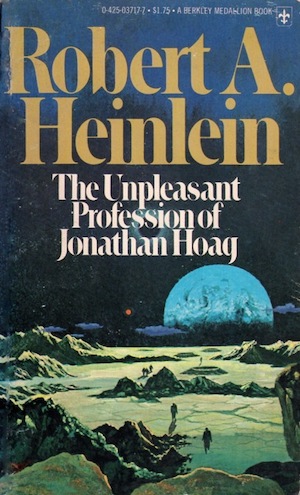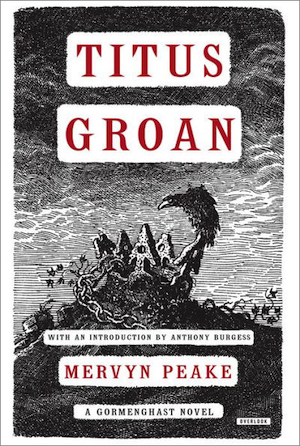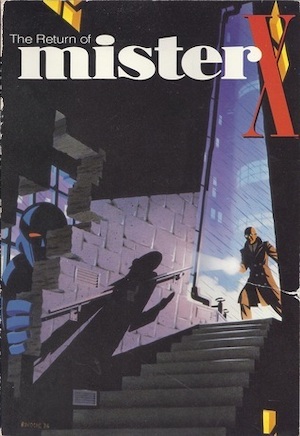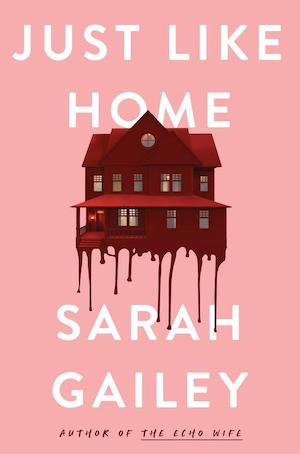There’s so much negativity in the world in which we live, and the internet only seems to exacerbate our unfortunate tendency to spotlight faults and shortcomings rather than looking on the brighter side of life. In the name of the optimism and positivity for which I am famous, I’d like to redress the balance. Consider the infamous1 H. H. Holmes.
These days, discussion of Holmes tends to focus on his more regrettable and extremely murderous proclivities, but in his way, Holmes was also an architectural visionary (depending on which accounts you believe—at the very least, Holmes’ “Castle” contained some hidden rooms, though it’s thought that they were mostly used to hide bits of furniture he hadn’t bothered to pay for). So, in the spirit of recognizing Holmes’ dubious achievements in building design and construction, here are five SFF works featuring bizarre and daring architecture!
The Bailey House (from “—And He Built a Crooked House—” by Robert A. Heinlein)

Frustrated by the limitations of Euclidian geometry, architect Quintus Teal yearns to construct for the Baileys a home unbounded by mundane dimensions. Physical practicalities appearing to preclude constructing the non-Euclidian structure he envisions, Teal settles for a three-dimensional representation of a hyperdimensional home. One fortuitous tremor later, and the construct folds, along dimensions humans cannot perceive, into the very form of which Teal dreamed.
Will the Baileys be delighted by their hyperdimensional home? Will they survive their first tour? These are questions that can only be settled by venturing into the hypercube house.
I wonder if a tendency to shuffle into a trans-dimensional mode is covered by building codes? Such a shuffle doesn’t seem like it would be directly life-threatening, although I can see how needing to navigate directions humans cannot perceive could be troublesome. Particularly if one were looking for the toilet.
Castle Gormenghast (From Titus Groan, by Mervyn Peake)

The earldom dominated by rambling Castle Gormenghast is surrounded on all sides by forbidding geography. Castle Gormenghast itself is a vast Gothic structure whose labyrinthine extent is poorly documented (and judging by certain events, even more poorly maintained). It’s the perfect setting for young Titus and his collection of dubiously sane relatives to pursue their eccentricities to their logical conclusions.
There are many aristocrats (most of whom are now dead) who tempt one to consider the benefits of guillotines. In the case of Titus’s extended family, while they do seem like bad bosses, the Castle appears to contain them quite effectively. The Castle is a kind of a roach motel for inbred blue bloods.
Radiant City (From The Return of Mister X by Dean Motter, Gilbert Hernández, and Jaime Hernández)

Radiant City as originally envisioned would have provided its inhabitants with utopia; its very geometries were planned to encourage the best in human nature. Practical considerations demanded extensive compromise. Result: a world-class city whose bizarre geometries erode human minds.
The good news is that Radiant City’s architect, now known as Mr. X, is determined to use his knowledge to counter the ill effects of Radiant City psychetecture. Too bad that the government, fearfully corrupt, opposes him. Even worse: Mr. X uses drugs to remain awake and productive—drugs that are eroding his sanity and compromising his judgment. Ill effects march on.
The City (From Girl’s Last Tour by Tsukumizu)

Long before sisters Yuuri and Chito were born, humanity demonstrated its unchallenged dominance over puny nature by constructing a vast complex of metropoles and megastructures covering (as far as can be gleaned from the manga) the entire surface of the Earth. Human supremacy was made manifest.
As Yuuri and Chito spend six volumes discovering, one consequence is that setbacks became non-recoverable: if civilization falters, if people forget how to repair the machines on which they depend, only lingering death and final extinction are possible. Nevertheless, the reduction of the Earth’s ecosystems to a small handful of dying remnants stands as an impressive triumph of the human will and vision.
Crowder House (From Just Like Home by Sarah Gailey)

Vera Crowder returns to her natal home to care for the sickly mother who cast Vera out twelve years ago. Following public revelation of Vera’s father Francis’ curious hobbies, Vera has tried to hide her connection to infamous serial killer Francis Crowder. Her mother, in contrast, embraced notoriety for its income potential. Neither truly appreciates the legacy Francis provided in the form of Crowder House itself.
Vera’s situation—the daughter of a famous serial killer moving in with a mother who blames Vera for her role in Francis’ downfall, returning to a town populated by the relatives of her father’s victims—may seem fraught. Let me assure readers it’s so much worse than it appears. The result is the exact opposite of a feel-good novel.
***
Strange and unusual architecture has inspired many authors; the works I’ve mentioned are only a small sample of what is doubtless a very large number of such works. Readers who have their own favourites not yet mentioned may feel free to mention said works in comments, which are, as ever, below.
In the words of fanfiction author Musty181, four-time Hugo finalist, prolific book reviewer, and perennial Darwin Award nominee James Davis Nicoll “looks like a default mii with glasses.” His work has appeared in Interzone, Publishers Weekly and Romantic Times as well as on his own websites, James Nicoll Reviews (where he is assisted by editor Karen Lofstrom and web person Adrienne L. Travis) and the 2021 and 2022 Aurora Award finalist Young People Read Old SFF (where he is assisted by web person Adrienne L. Travis). His Patreon can be found here.
[1]Not to be confused with Anthony Boucher, who adopted H. H. Holmes as a pen name. Boucher focused his energies on writing and editing and not, uh, other stuff. At least as far as we know.











The House in Susanna Clarke’s Piranesi. A beautiful, strange, very large house, essentially a world of its own. The best fantasy novel of recent years.
Sorry about the double comment. Don’t know what happened there.
The title structure in Gene Wolfe’s The Sorcerer’s House is a neat house as well.
The House in the James Stoddard “High House” series.
Castle Perilous!
Castle Amber, especially once we get past the first series and start to get a sense that the Pattern in the Basement isn’t the half of the weird architecture.
For once, you led with the story I first thought of when I saw the topic.
The House of Many Ways, by Diana Wynne Jones. I particularly liked the ability to request afternoon tea, and have it magically appear.
Hill House. All those weird angles and the doors doing strange things . . . =8-O
There’s always Hill House. And the three houses that make up Beldam on the Alabama coast in Michael McDowell’s The Elementals. And the house in Grady Hendrix’s How to Sell a Haunted House, which makes up for minimal eldritch architecture by being full of handmade dolls and puppets, a horror all its own.
The first house that I distinctly recall reading about that gave me the shivers by not being up to code was Shaw House in Robert Louis Stevenson’s Kidnapped. David Balfour nearly taking a dive off the top step stuck with me for a long time.
There’s our old favourite, the Overlook Hotel, from The Shining, book and film. Its architecture seems mundane, but people do tend to run into the most interesting inhabitants.
1985’s House was also fun, as I recall.
I’ll finish with a mention of the house in Lauren Beukes’s The Shining Girls. I thought the television series was excellent, and am waiting for enough time to pass to make the book a fresh experience.
Following on @@.-@, Ursula Vernon’s Castle Hangnail.
This is a children’s book, and not really SFF at all, but I immediately remembered Mrs. Piggle-Wiggle’s upside-down house (Betty MacDonald). Did anyone else ever wish to have cool chandelier fires and slushy floors?
The Riddlemaster trilogy by Patricia A. McKillip features a tower with an infinite spiral staircase to the top.
The mansion in Tsumiko and the Enslaved Fox by Forthright is enchanted by the titular fox so that certain rooms seem to move around, and the giant glass conservatory that is visible from the outside is impossible to find from the inside without his invitation.
In The Queen’s Thief series by Megan Whalen Turner, the Attolian royal palace was designed the neighboring kingdom’s spymaster, specifically to allow him and his descendants to sneak around more easily. It even features a “conspiracy room,” that is too awkwardly located and sized to be used for any legitimate business and has a drop ceiling so that the Thief can sit there and listen to clandestine meetings. How the Thief of Eddis pulled off becoming the Attolian royal architect is never explained.
House of Leaves, of course
For sheer size the Fastness from Iain M Bank’s Feersum Endjin would definitely qualify as an architectural oddity.
I’m a bit surprised no one has mentioned Hogwarts Castle yet.
“The Big Front Yard” by Clifford D. Simak features a house that is expanded in a wonderful way.
The titular Gunnerkrigg Court from the webcomic by Tom Siddell is an entire cluster of dreamlike architecture. To give only one example: Among other things (many other things), the Court is a boarding school. Each year the students move into another bizarre dorm. One year each room is a loft and they are stacked vertically and accessed by a single, very long ladder. Another year they move into underwater apartments strung along both sides of an access tunnel, like some kind of aquatic plant writ large. And so on.
There are so many great examples of this phenomenon, I’m enjoying seeing what others bring up. My contribution both chilled and comforted my subconscious: The House, the limitless concatenation of structures from Tad Williams’ Otherland saga.
If we’re talking manga, Blame! is an architectural experience like no other. It’s the best visual depiction I’ve ever seen of megalithic, far-future cityscapes.
@14 I thought about it, but thinking about Harry Potter these days just depresses me.
Oh, I forgot! Read a fun book once called Princess Ben and the castle featured these cool magical hallways that connected each room, but not the room itself, they each had like a vestibule. It was ‘tradition’ but no one knew why until Ben found out how to sneak around through them.
it’s a bit of a Cinderella/sleeping beauty story, very enjoyable.
The works of B.S. Johnson (Discworld)
Somewhat more mundane – Todos Santos (and other arcologies in other fiction), Dros Delnoch, the Imperial Residence in Vorbarra Sultana.
Steven Brust, Vallista. Vlad Taltos spends the novel wandering through a magical Estate house.
In the second season of the horror anthologoid podcast The Magnus Archives, there’s an episode called “The New Door”. It has a real doozy of an ending which would have done Rod Serling proud.
The house in A Discovery of Witches. It senses visitors and in preparation creates additional space to accommodate them.
What about the Imperial Security Headquarters in Vorbarra Sultana. I have the impression that it was an ungodly hybrid of Gothic and Brutalist design (at least Brutalist with Gothic touches).
#10: Mrs. Piggle-Wiggle is clearly in bounds genre-wise; the second book in the series is explicitly titled Mrs. Piggle-Wiggle’s Magic, and a number of the cures over the series’ five volumes are achieved by powders and potions with decidedly extraordinary effects. (One half-suspects that the late, never-seen Mr. Piggle-Wiggle studied the same curriculum as L. Frank Baum’s Dr. Pipt, maker of the Powder of Life and other chemical wizardries.)
More generally, Charles de Lint gives us Tamson House in his early novel Moonheart, which straddles the border between horror and high fantasy (and which I think may be his best book, a long subsequent career notwithstanding).
One other: In L. J. Smith’s The Night of the Solstice, also written for young readers, a house on a hilltop in suburban Southern California serves as gateway and counterpart to its twin in the parallel Wildworld, built by sorceress Morgana Shee (who is in fact who you may think she is based on that name, though in Smith’s telling she’s definitely not the villain of the piece).
In the Uncle books by J. P. Martin, Uncle lives in Homeward:
Jonathan Lethem wrote a response story to the Heinlein https://www.newyorker.com/magazine/2021/03/08/the-crooked-house
William Hope Hodgson’s House on the Borderland must qualify.
@21 stewart:
I assume you mean the character and not the 1890s con artist. The latter is what came up on my first search for B.S. Johnson.
#28 Thanks for that link! Just read it, and Lethem’s relationship to genre is fascinating – he doesn’t _deepen_ it at all. This is a literary homage to an existing form, a small well written riff. A mood piece, but not a thought piece. Lethem inhabits the architecture already built, no wacky extensions or profound illuminations here.
It was fun though. And made me think of the writers who do grapple with their childhood influences and take them places.
Weird architecture is a common trope occurring in the world of the SCP Foundation.
And almost every Lovecraft story wouldn’t be a Lovecraft story without some reference to “impossible angles” or “non-Euclidean geometry”, or other architecture themes.
In Glory Road by Heinlein, the Egg of the Phoenix is guarded by the Never-Born, Eater of Souls, in a Tower of great complexity. I’m not sure it actually violates geometry, but it’s weird.
The Scholomance in Naomi Novik’s eponymous series. Changing distances between known points, monster-infested to the max.
Nice library, though.
@31 : Lethem is doing a series of responses to the stories that were in a formative anthology for the young Lethem ( see here https://www.newyorker.com/books/this-week-in-fiction/jonathan-lethem-10-31-22)
Edgewood, the Drinkwater house in John Crowley’s Little, Big, should also make the list.
Castle Heterodyne. Weird, self-aware, ever changing, murderous and fiercely protective of its master.
If children’s books are in then Howl’s Moving Castle is a definite runner.
Castle Asu’a and Geloe’s Baba Yaga-inspired cottage from Tad Williams’s Memory, Sorrow and Thorn could belong on this list, as well as the castle that Quiss and Ajayi are imprisoned in in Iain Banks’s Walking On Glass.
House of Stairs (1974) by William Sleator has always stuck with me, still so many questions about the structure.
Possibly out-of-genre, but at least some of Escher’s drawings have buildings with very twisted geometries.
Andre Norton’s Octagon Magic. A magical dollhouse inside the octagon house fascinates a young girl as she explores the history of the house.
The Magic Faraway Tree, by Enid Blyton. Just your average enormous tree housing unusual people, with a different Land at the top of it that changed at various times. One wonders if there was some sort of roster.
The gangster’s house in Tim Power’s Last Call? I got the impression it was a historical place in fact. The words “bolt hole and hidey hole” were memorable.
Pelman the Powershaper’s conversations with the pigeon detesting House in the Wizard in Waiting also come to mind.
The Inn from the Innkeeper Chronicles by Ilona Andrews
The Castle from Tuesdays at the Castle by Jessica Day George (children’s series)
OK, you had me at Architecture.
Thanks, James, for not infrequently finding stories that bring together my interests (IOW buildings and SF&F).
The maze at the heart of the castle by Dorthy Gilman.
As others have mentioned, both Tad Williams, and the late – and seriously lamented – Iain (M.) Banks, are/were masters of this feature.
Whimbrel House from “Keeper of Enchanted Rooms” by Charlie N. Holmberg. Let’s just say it’s erratic (changing stairs to slide under your feet is one of its lesser tricks), but if you can reason with it you can get a room for a cook that has not been there before. And if you need to check something in the foundation you just have to ask nicely to rise a corner… :-)
Someone has already mentioned Hogwarts, but there are several other dubious structures in the HP universe, not least The Rookery, Luna Lovegood’s home, which is built as a giant chess piece and has at least one explosively unstable feature.
Anything built by Bloody Stupid Johnson in the Discworld series probably qualifies – Unseen University has at least one of his designs if I recall correctly.
The Starless Sea by Erin Morgenstern
The Hollow Places by T Kingfisher
The building which kicks off the mystery in Shadow of a Broken Man isn’t terribly bizarre- except it bears all the telltale signs of having been designed by a very particular architect- who died years before the building was conceived of.
The name of the book escapes me, but I recall a story where, as an elaborate tax dodge, a wealthy man had ordered the construction of a house with an ever changing interior layout, including keeping his bed constantly on the move (he had built it on the border between two countries, see, and wished neither to be able to claim it for tax purposes).
The Palais Garnier Opera House in The Phantom of the Opera comes with an assortment of secret passage, trapdoors, subterranean passage, and such to suit its theatrical needs- and some extras snuck in by the eponymous subcontractor.
The Babel tower in the books by Josiah Bancroft (Senlin Ascends, Arm of the Sphinx, etc.) is a huge tower where every floor is a whole world…
@45- time to re-read!
A lot of mysterious houses in jf and YA. The House with a Clock in its Walls (John Bellairs) and The Diamond in the Window (Jane Langton).
Spent a lot of my childhood going away for the summer (by book travel) to a house that led somewhere else. Although one house itself was mundane, it had a WarDrobe . . .
Randall Garret did a parody story in which an intrepid Ctulhuoid explorer investigates a building on a newly risen island. Lots of description of the weird Euclidean architecture with its straight lines and sharp corners. I still remember the last line (after which I presume the explorer went mad) “The horrible straight limbs each ended in 5 fingers or toes … and the entire body was nailed to monstrous cross!”
@37: Howl’s was my first thought — especially when @5 mentioned the book advertised as its sequel. (It’s more like in-the-same-universe.) Jones seems to have been fond of strange architectures, such as the house with overlays of other houses in Conrad’s Fate or the convention hotel in Deep Secret. AFAIK Jones never visited the 1990’s Lunacon hotel, in which a level passage connected the 7th floor to the 4th floor, but she probably knew even weirder hotels from going to cons in England.
@0: Finding the loo should be easier in the collapsed house, since you no longer have to go through the central space to get from one wing to another; it’s getting out that is difficult. NB: An interview in some glossy magazine (Elle? Vogue? Something that for some reason came up on Making Light several years ago) strongly suggested that Heinlein’s description of Laurel Canyon (possibly read in Time Probe, given the timing and description) is what convinced Joni Mitchell to move there.
In Thistlefoot (very recent), a couple of disagreeing siblings have become ?saddled? with Baba Yaga’s house — which has a number of odd interior features to go along with its ability to walk about. How it got that way is part of the story.
Charon’s Crossing in TJ Klune’s Under the Whispering Door (2021).
Once again I am put in mind of Dan Simmons’ Hyperion, with elaborate houses having rooms connected only by farcaster, with the result that one “house” could span many different planets…
One might also mention David Mitchell’s Slade House.
The Green Knowe series of children’s fantasy books by Lucy M Boston features a marvelous magical house. One of the books won the Carnegie Medal and two were runners up.
Gene Wolfe was already mentioned, but the Book of the New Sun has several interesting structures. The Tower which turns out to be a grounded spaceship; the House Absolute, which (among other things) has works of art on the walls which turn out to be actual rooms you can step into, and the Library, which is so vast that one can traverse significant amounts of the city just by entering and exiting from different access points.
It’s not traditional fiction, but the the game “What Remains of Edith Finch” is definitely a story, and the Finch House is a pretty crooked house. If you can find all of the rooms in the house, you get the full story of Edith’s very odd family.
If you don’t like to play games, there are some great play throughs of it on YouTube. I’m partial to jacksepticeye’s, but he does tend to cuss.
I humbly submit Fritz Leiber;s “The Jewels in the Forest” (1939)…For those unfamiliar with his work , you can thank me later.
@40 – Escher’s drawing showed up in Niven’s ‘Protector’, when Brennan-Pakmonster built Relativity into his ‘castle’
@40 – Escher’s drawing showed up in Niven’s ‘Protector’, when Brennan-Pakmonster built Relativity into his ‘castle’
Nancie@61, yes, but… if it wasn’t for the fact that you can see its stranger architectural features (like the turrets, etc) from the ground before you start, I’d venture to believe that they didn’t really exist. I don’t believe Edith ever actually gets up there, even though the game tries very hard to convince you that she does. (Why not? Because the power was out, disconnected for years. She spots that as soon as she gets into the house, but as soon as she ventures into the extremely odd basement lights start coming on, and by the time she gets up into the turrets there are all sorts of glittering christmas-tree decorations all over everything. How did that happen, with no power? Ergo, it never really happened: presumably the experiences that preceded that drove her mad, and everything from some point — perhaps the basement? — onwards was some form of hallucination. MAYBE. This is all very debatable :) )
The twin, contiguous, coexisting cities of Besźel and Ul Qoma in China Mieville’s The City & The City.
Though apparently there is nothing physically unusual about them except the way they are perceived by their inhabitants.
@60 – There was also Master Ashe’s house, in which different floors were in different possible histories
I fell in love with the unfolded crooked house, with its delicate floating staircases and subtle color schemes. The house as described before the folding is really beautiful.
Nice listicle about a beautiful topic.
I am surprised that nobody has yet mentioned the titular house of House of Leaves by Mark Z. Danielewski, which has a creepy “five and half minute hallway” and doors that appear between rooms without leading to any of them. The book itself is a marvel of architecture.
The Citacielle, in The Mirror Visitor Quartet by Christelle Dabos, is a gigantic flying castle in which there are houses, beaches, towers (inside the castle)… almost everything in it is fake, except the fact that it is clearly bigger on the inside.
In the same world, the Memorial is a library with walls and ceilings that have artificial gravity.
The TARDIS is also a home, if not a house, with… peculiar properties.
@69) Having made similar mistakes myself in the past, I will note that House of Leaves was mentioned all the way back at comment #12
Castle Gormenghast was the first architectural oddity that came to my mind, but I’ve always thought that Mr. Peake could have done more with the roof.
The Burrow, where the Weasley family lives. Despite its name, we never see what’s in the basement. Probably just as well, since there’s a ghoul in the attiic.
I’ll need to quote at length (from Goodreads). Forget Trantor, forget Coruscant.
“Share and Enjoy” is the company motto of the hugely successful Sirius Cybernetics Corporation Complaints Division, which now covers the major land masses of three medium-sized planets and is the only part of the Corporation to have shown a consistent profit in recent years. The motto stands – or rather stood – in three mile high illuminated letters near the Complaints Department spaceport on Eadrax. Unfortunately its weight was such that shortly after it was erected, the ground beneath the letters caved in and they dropped for nearly half their length through the offices of many talented young Complaints executives – now deceased.
The protruding upper halves of the letters now appear, in the local language, to read “Go stick your head in a pig,” and are no longer illuminated, except at times of special celebration.
…I recall this author, Douglas Adams, stating that he wanted a mysterious character who says “My name is not important” actually to have to admit to the rudest and most embarrassing name that BBC radio would broadcast, and they wisely negotiated him down to Slartibartfast, which only sounds rude if you know what he was meant to be called. But funny, and maybe this episode enjoyed the same improvement.
Can we mention Casa Madrigal even though we don’t talk about Bruno?
All of the sentient houses in Robin D. Owens romance stories have a heart stone or something like that at their center.
I also came here to mention Tamson House, form Charles DeLint’s “urban fantasy” Moonheart:
Charles de Lint: Moonheart: A Romance (1984) Description
Speaking of Patricia McKillip: Aislinn House, from The Bell at Sealey Head.
I’m taking lots of notes on the comments and suggestions. This is the exact sort of thing I’ve been fascinated with for a long time, and especially the older I get. Impossible spaces, alien geometries, shifting architecture, good stuff.
Also, regarding the first book in the original article: huh, I didn’t know Heinlein wrote a full novel of And He Built A Crooked House! Neat! Loved the short story.
The Chung Ko series by David Wingrove feature “cities” that cover entire continents.
Sunset Towers faced east and had no towers.
Ellen Raskin, The Westing Game
@31: I dunno…I think Lethem does a deft reversal of the usual nonsense about people who are forced to live in makeshift shelters or without any. They have a poor grasp of practicality. They fritter away their time on pointless things. They have to be reminded all of the time that they’re not welcome–thrown out even–because they keep showing up where nobody wants them. They keep ending up right back in the same place for no rational reason. They can’t think or communicate rationally, so there is no point in engaging with what they say. Blah blah blah. Except, it’s the narrator, who’s rich enough to lease a house, who’s doing all this, and the formerly unhoused people who have formed a working community even when they find themselves in circumstances that make no sense.
@78 – Heinlein did not write such a novel.
Both of the houses in Yah Yah Scholfield’s On Sunday’s, She Picked Flowers could fit here. Though they are more crooked in spirit & action than physical architecture I suppose
Kari Maaren’s YA novel Weave a Circle Round has an odd house. I forget all the details, but it gives passage back to Samuel Coleridge’s time and the hallways are always full of chairs.
Also a huge fan of Moonheart.
House of Leaves would be one of the first ones if I made this list, also Slade House by David Mitchell, and Piranesi.